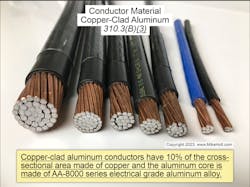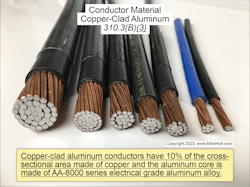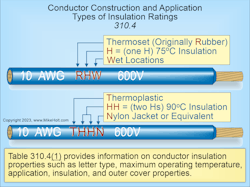Courtesy of www.MikeHolt.com
All questions and answers are based on the 2023 NEC.
Q. What are the rules related to minimum conductor sizing and material?
A. Conductor material types and sizing requirements are outlined in Sec. 310.3 [Conductors, Minimum Size and Material] of the NEC.
As noted in Sec. 310.3(A) [Minimum Size Conductors], the minimum sizes of conductors are 14 AWG copper or 12 AWG aluminum or copper-clad aluminum, except as permitted elsewhere in the Code. There is a misconception that 12 AWG copper is the smallest conductor permitted for commercial or industrial facilities. Although it is not true based on NEC rules, it might be a job specification or local code requirement. Conductors smaller than 14 AWG are permitted to be installed for Class 1 power-limited circuits [Sec. 724.43], fixture wire [Sec. 402.6], and motor control circuits [Table 430.72(B)].
As noted in Sec. 310.3(B) [Conductor Material], conductors must be copper, aluminum, or copper-clad aluminum. Aluminum and copper-clad aluminum conductors must comply with the following:
(1) Solid aluminum conductors 8 AWG, 10 AWG, and 12 AWG must be made of an AA-8000 series electrical-grade aluminum alloy conductor material.
(2) Stranded aluminum conductors must be made of an AA-8000 series electrical-grade aluminum alloy conductor material.
(3) The copper of a copper-clad aluminum conductor only makes up 10% of the cross-sectional area. The aluminum core of a copper-clad aluminum conductor must be made of an AA-8000 series electrical grade aluminum alloy conductor material (Fig. 1). According to Art. 100, “Copper-Clad Aluminum Conductor” is drawn from a copper-clad aluminum rod with the copper metallurgically bonded to an aluminum core.
As noted in Sec. 310.3(C) [Stranded Conductors], conductors 8 AWG and larger installed in a raceway must be stranded to be solid, unless specifically permitted or required elsewhere in the Code. A grounding electrode conductor is an example of where an 8 AWG and larger solid conductor can be installed in a raceway when it is required to be protected from physical damage [Sec. 250.64(B)].
Lastly, Sec. 310.3(D) requires conductors to be insulated unless specifically permitted to be bare.
Q. What Code rules address conductor construction types and use?
A. The requirements for conductor construction and application are outlined in Sec. 310.4 [Conductor Construction and Application, Minimum Size and Material] of the NEC. Table 310.4(1) provides information on conductor insulation properties such as letter type, maximum operating temperature, application, insulation, and outer cover properties (Fig. 2).
When a “–2” is found at the end of an insulation type (such as THWN-2), the conductor has a maximum operating temperature of 90°C and is suitable to be installed in a dry or wet location (Fig 3).
These materials are provided to us by Mike Holt Enterprises in Leesburg, Fla. To view Code training materials offered by this company, visit www.mikeholt.com/code.
About the Author

Mike Holt
Mike Holt is the owner of Mike Holt Enterprises (www.MikeHolt.com), one of the largest electrical publishers in the United States. He earned a master's degree in the Business Administration Program (MBA) from the University of Miami. He earned his reputation as a National Electrical Code (NEC) expert by working his way up through the electrical trade. Formally a construction editor for two different trade publications, Mike started his career as an apprentice electrician and eventually became a master electrician, an electrical inspector, a contractor, and an educator. Mike has taught more than 1,000 classes on 30 different electrical-related subjects — ranging from alarm installations to exam preparation and voltage drop calculations. He continues to produce seminars, videos, books, and online training for the trade as well as contribute monthly Code content to EC&M magazine.




